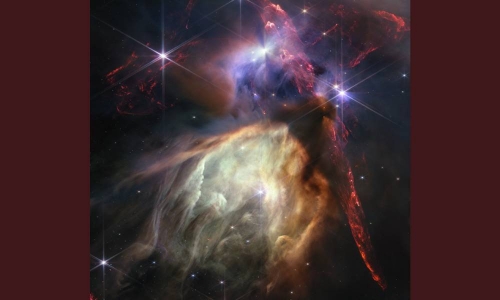NASA celebrates Webb telescope anniversary with close-up of stellar birth
AFP | Washington
The Daily Tribune – www.newsofbahrain.com
Jets of red gas bursting into the cosmos, and a glowing cave of dust: NASA marked a year of discovery by the James Webb Space Telescope Wednesday with a spectacular new image of Sunlike stars being born.
The picture is of the Rho Ophiuchi cloud complex, the nearest stellar nursery to Earth, whose proximity at 390 light-years allows for a crisp close-up by the most powerful orbital observatory ever built.
"In just one year, the James Webb Space Telescope has transformed humanity's view of the cosmos, peering into dust clouds and seeing light from faraway corners of the universe for the very first time," said NASA Administrator Bill Nelson.
"Every new image is a new discovery, empowering scientists around the globe to ask and answer questions they once could never dream of." Webb's image shows around 50 young stars, of similar mass to our Sun or smaller.
Some have the signature shadows of circumstellar disks -- a sign that planets may eventually form around them. Huge jets of hydrogen appear horizontally in the upper third of the image, and vertically on the right.
"These occur when a star first bursts through its natal envelope of cosmic dust, shooting out a pair of opposing jets into space like a newborn first stretching her arms out into the world," the US space agency said in a statement.
"At the bottom of the image, you can see a young star that's energetic enough that it's blowing a bubble in the cloud of dust and gas from which it was born," Christine Chen, an astronomer at the Space Telescope Science Institute, which operates Webb, told AFP.
It does so through a combination of its light and a stellar wind linked to it, she added. Interstellar space is filled with gas and dust, which in turn serves as the raw material for new stars and planets.
"Webb's image of Rho Ophiuchi allows us to witness a very brief period in the stellar life cycle with new clarity. Our own Sun experienced a phase like this, long ago, and now we have the technology to see the beginning of another star's story," said Webb project scientist Klaus Pontoppidan.
Webb boasts a primary mirror measuring more than 21 feet (6.5 meters) that is made up of 18 hexagonal, gold-coated segments, as well as a five-layer sunshield the size of a tennis court.
Unlike its predecessor Hubble, it operates primarily in the infrared spectrum, allowing it to look back nearer towards the start of time, and to better penetrate dust clouds where stars and planetary systems are being formed today. Webb has enough fuel for a 20-year mission, promising a new era of astronomy.
Related Posts

